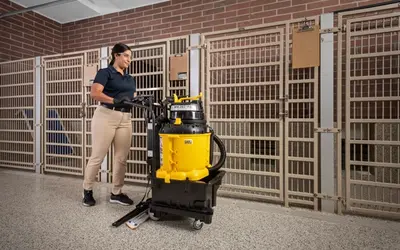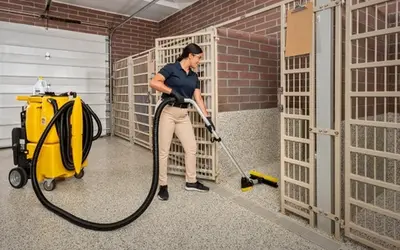A Grocery Store Cleaning Checklist

Grocery store cleaning is becoming a more complicated process as operations continue to expand their food services and increase their produce inventories. Custodians need to be able to maintain high cleaning standards in areas frequented by customers and employees while making sure that there is no chance for slip-and-fall accidents. Here’s a grocery store cleaning checklist for maintenance managers to create an efficient program.
Grocery Store Cleaning Checklist
1. Floors
Floor cleaning is one of the toughest jobs for grocery store management to tackle. Since you must cover a large amount of square footage, cleaning must be completed quickly and efficiently. Autoscrubbers and the AutoVac have both been proven to remove over 99 percent of soils. However, the latter system offers faster operation and quicker drying times, which makes it ideal for 24-hour stores that have little down time.
2. Checkout Aisles
Checkout aisles require careful consideration when it comes to cleaning. Shoppers often place food directly on the rubber tracks that move goods to the register. This leaves soils on the surface. In order to maintain safety standards for consumers, clerks should use disposable wipes to clean the counter and track throughout their shifts.
3. Deli Counters
You must keep food handling and safety precautions in mind when cleaning deli counters. Deli clerks should be aware of the steps they need to take to prevent cross-contamination when wiping counters, cutting boards, knives, and meat slicers. Critically, you should have a system in place that eliminates the risks involved with reusing rags to clean multiple areas. By having your employees use numbered microfiber towels or disposable wipes, you can prevent cross-contamination, which can lead to customer illnesses.
4. Walk-in Freezers and Refrigerators
Grocery stores have even more prepared food options these days. This means that you have to maintain high cleanliness standards in more places. As is the case for restaurants, proper food handling begins in walk-in freezers and refrigerators. Employees must keep food in solid containers in order to ensure that contaminants do not leak onto or fall into other foods. Your cleaning routine should start by emptying out your walk-in freezers and refrigerators. Once you empty out these appliances, you should clean the insides with no-touch products. Consequently, this will help you avoid contamination.
5. Restrooms
In high-traffic restrooms, like the ones in large supermarkets, dangerous contaminants can soil surfaces throughout the day. These restrooms require frequent spot cleaning as well as daily deep cleaning to ensure soil removal. While touch points like soap dispensers, stall doors, and sinks should be cleaned throughout the day, the rest of the restroom only needs to be cleaned on a nightly basis. Traditional cleaning tools, like mops and rags, can spread soil around. To prevent this cross-contamination, custodians should use more advanced cleaning systems such as our Kaivac No-Touch spray-and-vac equipment when cleaning restrooms.
6. Spills and Accidents
There is no grocery store that is immune to regular spills and other accidents involving messy foods. In these situations, it is important to consider the risks of slip-and-fall accidents and contamination. While autoscrubbers can provide an effective clean, they leave a wet surface. This means that you will have to stop operations in the area to ensure that the conditions are safe for customers and employees. Custodians should use a fast-drying cleaning system. For example, a wet/dry vac ensures that soil is removed and there is no risk for slip-and-fall accidents.
The above grocery store cleaning checklist will help maintenance managers create an efficient program. Of course, each of the above sections could be a blog unto themselves, and many of them already are. Browse our other articles for more cleaning insights.
Click here to learn more about Kaivac’s Grocery and Retail Cleaning Solutions.
Related Posts

The Best Dog Kennel Cleaning Equipment
There are ways to simplify the kennel cleaning process. Automatic kennel cleaning equipment can simplify the kennel cleaning process and can save hours of daily, back breaking labor–even for facilities without central drains.
Read more
A Better Retail Floor Care Option: How One National Retailer Reclaimed Floor Care
Discover how a national retailer cut costs and improved results by switching to Kaivac’s All Floor™ system—an easy, all-in-one floor care solution perfect for low-revenue retail locations.
Read more
The Prodigal Pooch Loses Odors, Gains Clients Thanks To No-Touch Cleaning System
The change at The Prodigal Pooch was immediate. After just two days of using No-Touch Cleaning the look, smell, and feel in the kennel rooms improved. Two weeks later the odor was completely gone.
Read more